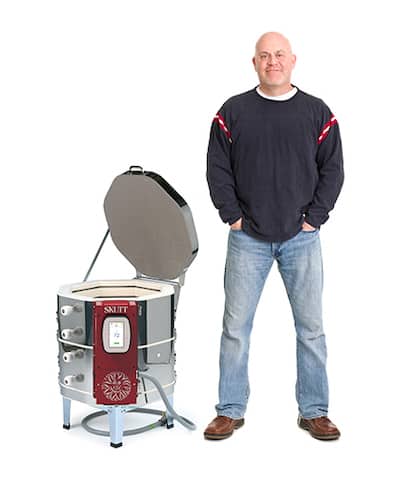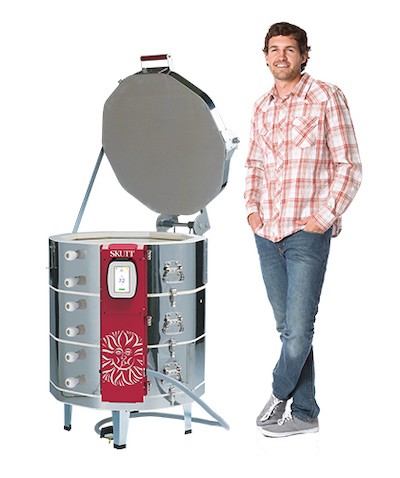Your cart is currently empty!
What Size Kiln Do I Need? –Take Out the Guess Work
Published:
Last Updated:
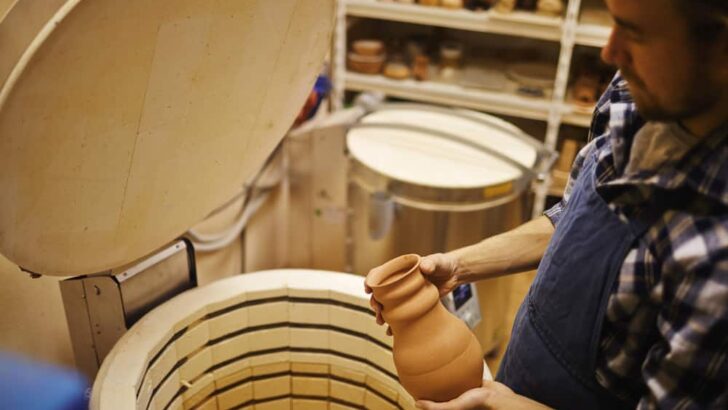
Affiliate Disclaimer
As an affiliate, we may earn a commission from qualifying purchases. We get commissions for purchases made through links on this website from Amazon and other third parties.
Buying a kiln is exciting, but perhaps you are wondering what size kiln do I need. You will probably get conflicting advice from different people about what size to buy. When I was considering buying my first kiln, I found it all a bit overwhelming. So, I did a lot of research and this is what I found out…
A kiln’s internal chamber is measured in terms of diameter and depth, but also in cubic feet. The size of the kiln you need depends upon how big your pottery is and how much you produce. It also depends on what cone you fire to and what power supply you have.
With so much to bear in mind, it can feel a bit daunting to decide on a way forward. So let’s start with dimensions…
What Size Kiln do I Need? – Some Measurements
Kiln size is measured in a couple of ways.
- The diameter and depth of the internal cavity in inches
- The cubic feet capacity of the internal chamber
These measurements tell you about what is referred to as the ‘chamber capacity’.
It sounds weird to say, but kilns are like dogs. What? This is getting a bit Salvador Dali. Well, what I mean is that kiln sizes range enormously.
Some kilns are as small as 0.6 cubic feet. Kilns this small are usually used as test kilns, to try out new techniques on one piece. Or they might be used for jewelry or making ceramic dolls. However, kilns range all the way up to massive industrial kilns at 100 cubic feet.
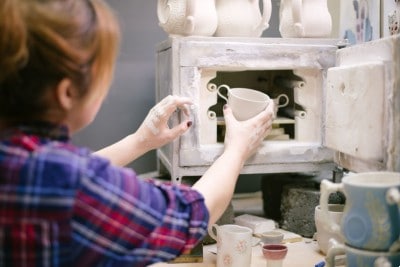
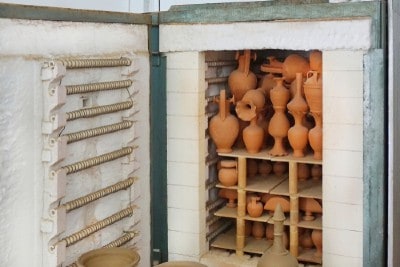
So, when I say kilns are like dogs, I mean they vary hugely in size. If you put a Chihuahua next to a Great Dane, you’d be forgiven for thinking were different species. Forgive the analogy, but I’m a dog lover. What I mean is that very small kilns seem to have little in common with very large kilns.
Not only that, but different manufacturers make kilns with different measurements. There is a lot of variety out there, and a lot to think about.
However, for the purposes of buying a kiln, it’s helpful to break down the categories into small, medium, and large.
Small – Medium Kilns
Manufacturers will categorize kilns differently. However, broadly speaking smaller kilns range from 0.6 to around 6 cubic feet.
Some examples of how the dimensions of an internal chamber relate to cubic feet are as follows:
| Diameter | Depth | Cubic Feet |
|---|---|---|
| 11″ 16.5″ 17.5″ 22.5″ 23.5″ | 9″ 22″ 22″ 22″ 22″ | 0.6 2.9 3.2 5.25 5.7 |
The Skutt KMT-818 is a good example of a smaller kiln. It’s compact enough to fit into most small studio spaces. And it makes a good home kiln.
In spite of being compact, Skutt helpfully specify that you can fire up to 12 bowls at a time in this kiln. This assumes that the bowls are 6 by 3″.
- Diameter: 18”
- Depth: 22”
- Cubic Feet: 3.2
- It fires to cone 10
It’s a single-phase kiln. And Skutt makes a model that runs on 208V or one that runs on 240V.
Medium – Large Kilns
Medium to large kilns are generally between 6 and 9 cubic feet.
| Diameter | Depth | Cubic Feet |
|---|---|---|
| 22.38″ 28″ 23.38″ 28.13″ | 27″ 17.75″ 27″ 22″ | 6.4 6.6 7 8.1 |
The Skutt KMT 1027 is a good example of a mid-sized kiln. 23 x 27″ kilns a probably the most popular sized kilns.
This model has a chamber capacity large enough to fire up to 38 x 6-inch bowls at once.
If you make bigger pieces, it is tall enough to fire a 23” pot. Alternatively, it’s wide enough for a 21” platter.
- Diameter: 23”
- Depth: 27”
- Cubic Feet: 7
- It fires to cone 10
Large Kilns
Larger Kilns are anything from 9 cubic feet up. Kilns of this size are production kilns. They are used by professional potters that produce and fire high quantities of pottery. In terms of capacity, they can fire around 50 or more 6-inch bowls or equivalent.
| Diameter | Depth | Cubic Feet |
|---|---|---|
| 28.13″ 28.13″ | 27″ 31″ | 9.9 11.6 |
This is not an exhaustive list of all the dimensions you can buy a kiln. However, it gives you an idea of the range available.
So, what does all this mean in terms of how much you can fit in your kiln? Read on, and I will look into this in a bit more depth…
What Size Kiln Do I Need – How Much Can I Fit in a Kiln?
It’s all very well having the dimensions of a kiln, but it can be hard to visualize what these mean.
You may be wondering how much pottery you can actually fit into a kiln that is say 17.5” x 22”. Knowing that this is 3.2 cubic feet, may give you some idea. But still, cubic feet can be hard to visualize too.
What’s more, a photo of the inside of an empty kiln does not help too much when visualizing its capacity. Take this photo for example. Is it the size of a hatbox or an oil drum? You just can’t tell. So if you’re browsing kilns online, a picture may not help you get a clear idea of size.
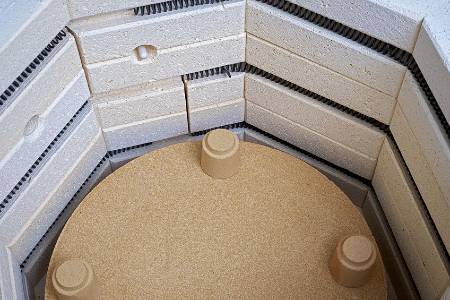
I know I’m laboring the point. However, it’s easy to buy a kiln and be surprised by the size when it arrives. You might either be disappointed that it’s smaller than you thought. Or you might feel overwhelmed that it is larger than you feel you need.
Either situation is not great. If you get a kiln that’s too small, you will have to fire more than you want. Also, you will always have a nagging feeling that you need to upgrade sooner than you want. Equally, if it is larger than you need, you will need to wait a long time to fill and fire it.
So, what should you do? How do you know what you will be able to fit in your kiln? Well, here is a visual representation of what you could fit in a couple of kilns. It is based on the assumption that the pottery items are 6 by 3-inch bowls.
How Much Can You Fit in a Kiln? – Handy Diagram!
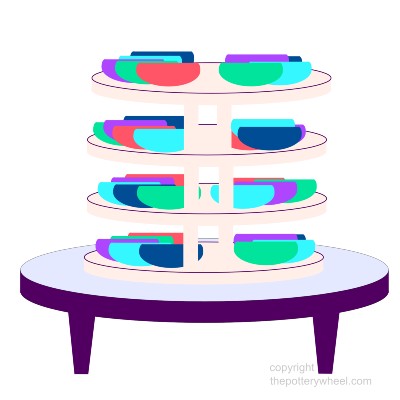
You can comfortably fit up to 38 bowls in the kiln, provided the bowls are 6 x 3″.

Mock Up your Kiln’s Inner Chamber
However, here is a tip from Northern Kilns if you want to figure out exactly what a kiln of any size will look like.
If you are thinking of buying an 18” by 18” kiln, cut out 5 pieces of cardboard with those measurements. Then put them together to mock up the kiln itself. Place one piece on the floor as the base of the kiln. Then use two pieces as the sides and one as the back. Then finally put the last piece on the top to represent the lid of the kiln.
This will give you an exact idea of what the kiln’s inner chamber will look like. So, no unwelcome surprises when your kiln arrives.
What Size Kiln do I Need – Other Considerations:
There are other factors that will affect what size of pottery kiln to buy. Here they are:
Kiln Shelves Take Up Space
Remember that when you fire, pottery does not sit on the very bottom of the kiln. Instead, you will have a bottom shelf that sits on props. The props and kiln take up about 2 inches. So, whatever the internal depth of the kiln 2 inches of that will be taken up by the bottom shelf.
The same goes for any shelving in a kiln. You need to take into account the depth of the shelf when working out how much internal space you have.
How Big is Your Work? Is It Going to Get Bigger?
Where are you at with your pottery practice? Is your pottery going to stay the same size over time? Or, is it going to get bigger as you develop your skills? It is possible that you know for sure that you will want to continue making smaller pieces. Perhaps your passion is soap dishes. If that’s the case, then you know that you most likely will not outgrow your kiln.
However, if your work is gradually getting bigger over time, it’s a good idea to buy a kiln with a bit of extra space to grow into. Larger kilns do cost a little more to run. And it may be that in the short run you are firing your kiln when it is less than full. However, if you outgrow your current kiln quickly, you will end up spending much more on a new kiln.
How Much Do You Produce?
In addition to considering the size of your work, you need to think about how much you produce. Let’s say you like to make large pieces and you can only fit one or two in the kiln. If you make one large piece a couple of times a week. Then you can get a kiln that is just large enough to fire one or maybe two large pieces.
But what if you are making a large piece like that every day? You wouldn’t be able to run your kiln enough to keep up with your production. A glaze fire can take around 24 hours in total. This period of time includes firing and cooling down. So, if you are bisque firing and glaze firing, you wouldn’t have enough time to fire all your work. You would always have a backlog.
If this is the case, then investing in a larger kiln would make much more sense.
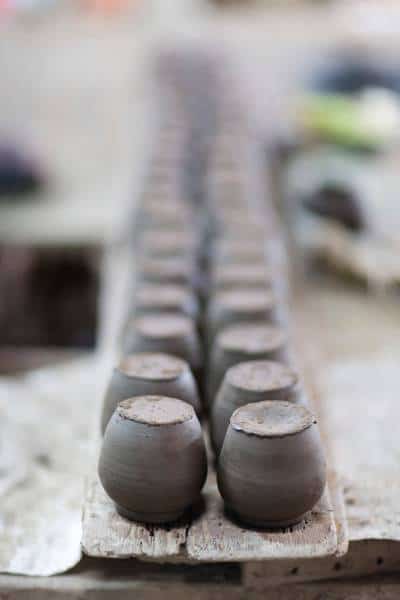
Bisque Firing V’s Glaze Firing
It’s worth bearing in mind that you can fit more pottery in a kiln when you are bisque firing. Greenware can be stacked a bit so it’s sitting inside of other pieces. By contrast, when you are glaze firing pieces cannot touch one another. This is because the glaze melts and the pieces would stick to one another. So, you need space between them.
How Much Space Do You Have?
The amount of space you have in your studio will affect what size pottery kiln to buy. Whether you have your kiln at home or in a dedicated studio, they take up quite a bit of space.
You can expect your kiln to be at least 8” bigger all around than the internal chamber. And in addition to this, your kiln needs to be at least 12” away from any walls or objects. In fact, some suppliers recommend a clearance space of 18”.
Kiln Size and Power Requirements
Finally, the size of kiln you buy will determine how many volts, amps, and watts you need. By and large, only smaller kilns will function on 120V. Most mid-range kilns will need 208 or 240V. Similarly, larger kilns require more amps and will need a breaker size of a higher value in your electrical circuit.
Maximum Temperature Reached
A lot of smaller kilns will fire up to cone 10. And the advantage of a smaller kiln is that it heats up and cools down quicker than bigger models. Nevertheless, some smaller kilns will only fire up to cone 6. So, it’s worth being clear about the kiln’s maximum temperature before you buy.
What Size Kiln Do I Need – Final Thoughts
Buying a kiln is exciting and will give you a lot of freedom. But it is a big investment and commitment. It’s understandable that you want to be clear about what size pottery kiln to buy. I hope this article helped. One final recommendation would be to take your time and not rush into it. Once you have bought your kiln, you will likely have a long relationship with it. So, it’s good to know upfront that you have chosen the right one for you at this time.

